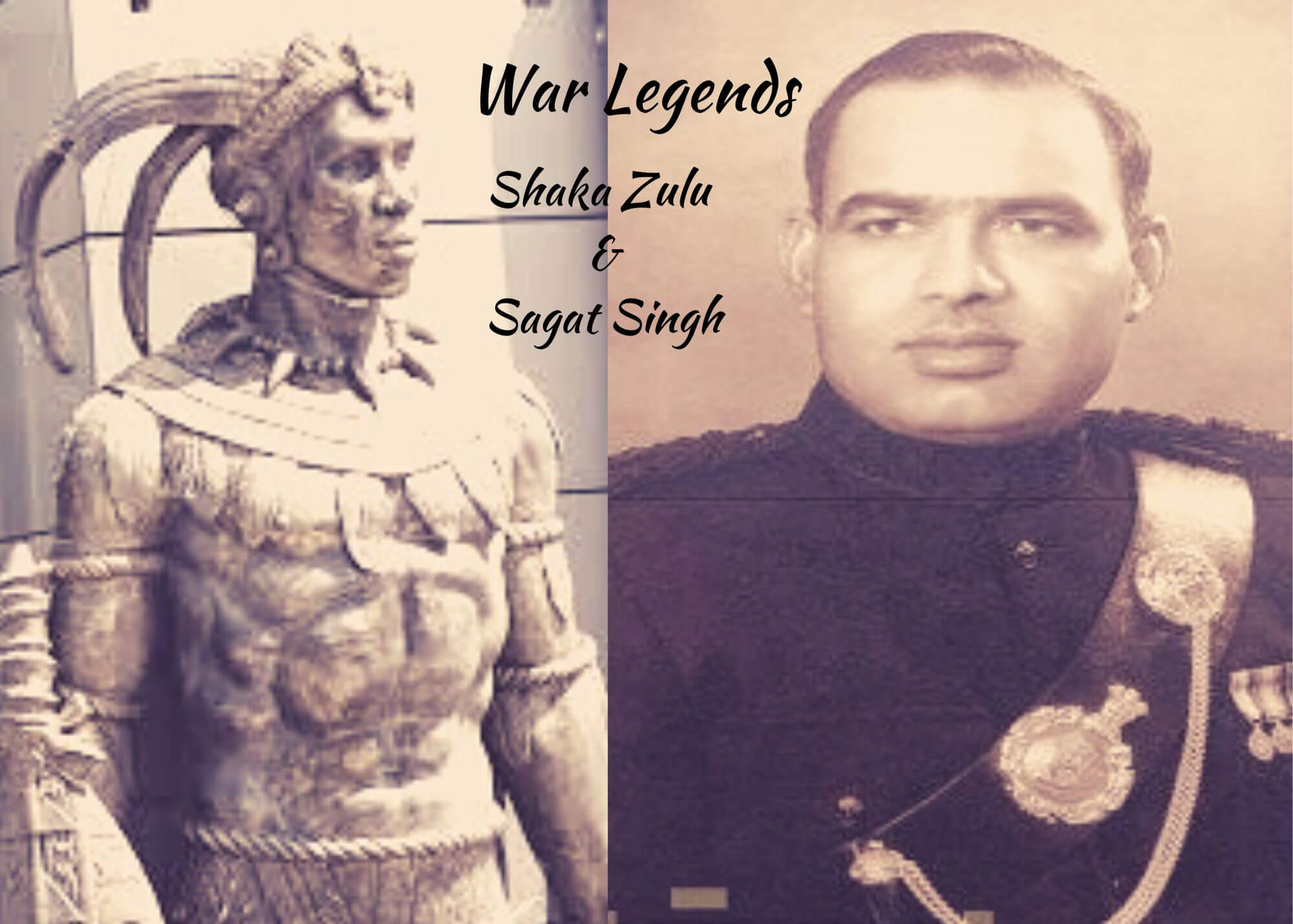Shaka Zulu and Lt. Gen. Sagat Singh shared remarkable legacies and enduring impacts on their respective nations, revealing a connection beyond coincidence, states Sanyogita, reflecting on reincarnation exclusively for Different Truths.
Growing up as Sagat Singh’s granddaughter was like living in a superhero action movie. He narrated all his combat stories, and we would listen with fascination to all his victory tales. As a child, I was awestruck to know that my grandfather could fire guns and cannons and throw bombs at enemies, and he was awarded and applauded for his warfare strategies. His favourite story was always the narration of the heliborne operation during the liberation of Bangladesh. His face lit up, and I could see the excitement in his eyes as if he relived the experience every time he spoke of that operation.
My father, Col. Ran Vijay Singh, served with the UN Peacekeeping Mission with the Botswana Defence Forces, Botswana, Africa, in 1986 and 1987. During our stay in Botswana, we followed a serial called “Shaka Zulu”. As a child, I enjoyed the series on the great warrior and leader, and it did have an impact, though, at the time, I did not understand why.
In 2019, thanks to Netflix, I started watching Shaka Zulu again.
In 2019, thanks to Netflix, I started watching Shaka Zulu again. Then the similarities hit me like a tornado, and the familiar waves began to flow. I did extensive research on Shaka Zulu’s history. The similarities are too many to be coincidental.
“Reincarnation is paralleled by science.
The first law of thermodynamics declares that energy can only transform; it cannot create or destroy power. – Karen Berg
Shaka kaSenzangakhona (July 1787–September 22, 1828), also known as Shaka Zulu, was the King of the Zulu Kingdom from 1816 to 1828. He was one of the most influential monarchs of the Zulu Kingdom, responsible for reorganising the Zulu military into a formidable force via a series of wide-reaching and significant reforms.
Creator of a revolutionary warfare style, several writers focus on Shaka’s military innovations, such as the iklwa, the Zulu thrusting spear, and the “buffalo horns” formation. This combination compares the standardisation implemented by the reorganised Roman legions under Marius.
Padma Bhushan Lt. Gen Sagat Singh, PVSM … changed the history and geography of India …
Padma Bhushan Lt. Gen. Sagat Singh, PVSM (14 July 1919–26 September 2001) changed the history and geography of India and the world. He remains the most successful general of the Indian Army post-Independence, having defeated the Portuguese, Chinese, and Pakistani armies in battle. He remains a legend and is remembered equally in Bangladesh as in India.
He is known as the master of tactical operations; he was always a few steps ahead of the others. He had that unique ‘ability to envision the end state and orchestrate time and resources to meet that end state.’ He is also the only corps commander independent India has produced whose accomplishments have sustained international scrutiny.
Name: Shaka and Sagat… five letters beginning with S. Need I say more? Their words spoken together are like calling out to twin brothers.
Dates: They were both born in July and passed away in Sep.
Physical Attributes: They were both tall men with attention-commanding stature, similar in build, gait, and postures, with thick lips and small eyes.
Military Innovations: Both have been pioneers in creating new warfare strategies. Shaka formed the Buffalo formation, and Sagat convened the heliborne operation and trained Bangladesh refugees to improve road communication between Tripura and then East Pakistan.
Shaka’s Buffalo attack formation for surrounding and annihilating enemy forces, the main force, the “chest,” closed with the enemy …
Warfare Tactics: In Shaka’s Buffalo attack formation for surrounding and annihilating enemy forces, the main force, the “chest,” closed with the enemy and pinned it in position, engaging in melee combat. And the “horns” would flank the enemy from both sides and encircle it; they would then destroy the trapped force. The “loins,” a large reserve, were hidden, seated behind the “chest”, with their backs to the battle, for the sake of not losing any confidence. The “loins” would be committed wherever the enemy threatened to break out of the encirclement.
Sagat led a similar formation of double entrapment, but he went a step ahead. He created the vertical formation, in which the enemy was surrounded and attacked from the air (the famous Heliborne Operation) and on land. This vertical attack was a massive blow to the Pakistan Army, as none of them had envisioned an attack from the air.
Both had a similar motive in their warfare tactics…That is, catch your enemy by surprise …
Both had a similar motive in their warfare tactics…That is, catch your enemy by surprise, attack them from all unexpected sides, and crush them. The double envelope tactic, or, I dare say, the devil’s entrapment
Personality: Shaka and Sagat are today known as tactical leaders and brave warriors who fought many battles and wars, respectively. Both had humble beginnings in life and became the most inspired leaders. The adjectives used to describe both are easily interchangeable. You represent one, and just as the same is true of the other, so are the prominence and fortitude of their larger-than-life personalities. Brave, courageous soldiers who rose to become warriors and leaders, full of audacity, and most importantly, both have left a great legacy behind.
Present-Day Legacy: The Zulu people are the largest ethnic group and nation in Southern Africa. The Zulu people, with an estimated 10–12 million people, live in the province of KwaZulu-Natal. They originated from Nguni communities that participated in the Bantu migrations over millennia. As the tribes integrated, the leadership of Shaka brought success to the Zulu nation due to his improved military tactics and organisation. Zulus take pride in their ceremonies, such as the Umhlanga or Reed Dance, and their various forms of beadwork, which acts as a form of communication and dedication to the tribe and specific traditions.
Today the Zulu people believe in Christianity but have created a syncretic religion …
Today, the Zulu people believe in Christianity but have created a syncretic religion combined with the Zulu’s prior belief systems. In memory of the great leader and warrior, the American firm Creative Kingdom Inc. designed uShaka Marine World, a 16-hectare (40-acre) theme park that opened on April 30, 2004, in Durban, KwaZulu-Natal, South Africa. It has a total capacity of 4.6 million gallons and contains 10,000 animal species. The King Shaka International Airport at La Mercy, 35 km north of the Durban city centre, was opened on May 1, 2010, in preparation for the 2010 FIFA World Cup.
Sagat’s legacy needs no introduction; two of his sons followed him and joined the Indian Army; his eldest son, my father, Col. Ran Vijay Singh, joined the 6th Mechanized Infantry (originally the 1st Garhwal Rifles), and my late uncle, Capt. Dig Vijay Singh joined my grandfather’s regiment, the 2nd Battalion, the 3rd Gorkha Rifles (2/3 GR). My uncle, a young captain, died while on active duty in the Army in Kashmir. My father has given exemplary service, including serving two memorable tenures, one with the UN Peacekeeping Mission with the Botswana Defence Forces, Africa, and the second with the NSG (National Security Guards), where he was commanding the Support Weapon Squadron at Manesar. He is now enjoying his retirement. Though I can say confidently from my first-hand experience of growing up in a house full of Army legends that no Fauji ever retires, Their sense of duty for service to the nation is paramount, and it lasts till their dying days.
Sagat has been honoured at all major cantonments in India. His bust has been installed in Jaipur, Jodhpur, and Bhatinda. Auditoriums and museums opened in his name, and roads are named after him in five cities, including Tezpur and Mhow. People of India and Bangladesh fondly remember Sagat Singh, and it is because of his vision that we are forever united in the soil and rivers of Bangladesh as a testimony to our eternal friendship and shared heritage and history.
… there are many other differences between Shaka and Sagat; those differences are only because of the timelines.
While Shaka and Sagat have many other differences, those differences are only because of the timelines. They are 132 years apart. Shaka saw the rise of the British Empire in Africa, and Sagat saw the liberation of India from the British Empire. It’s fascinating to see both prominent figures at the start and end points of the British Regime.
The title music track of the Shaka Zula miniseries released in 1986, sung beautifully by Margaret Singana, describes both heroes perfectly. Quoting a few lyrics below:
Be a Man of Greatness now,
A man so big and strong in mind
Be a man of wisdom now
A man of men, now let him shine.
This is what you are…this how it was planned now
This is what to be…every kind of man now.
I, for one, really believe in reincarnation; these two legends have too many similarities for this to be a coincidence. I hope, in either form, he doesn’t wait another hundred years to come back. I am proud to be part of Sagat’s legacy. I can only aspire to exhibit a small fraction of the magnitude of inspiration they have left for us.
“Reincarnation is a dance. It is the movement of life to the rhythm of the universe. Spirit and matter join as one dancing partner. They dance, and it goes on forever.” – Frederick Lenz.
Picture compilation Anumita Roy with pictures from the internet.





 By
By
 By
By
